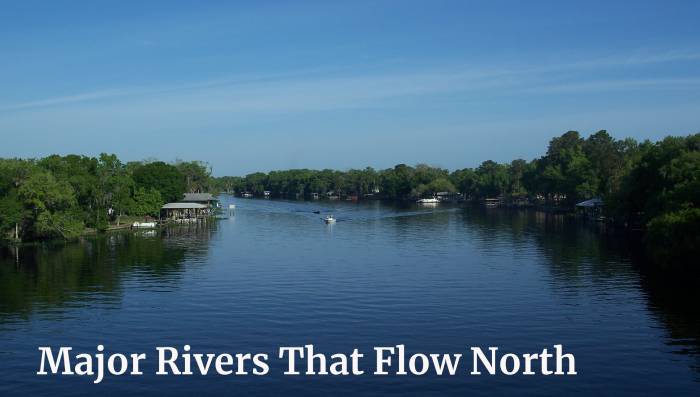It is a common misconception that all rivers flow south. Many people believe that rivers flow toward the equator (in the Northern Hemisphere) or flow down toward the bottom of north-oriented maps. The truth is that rivers (like all other objects on Earth) flow downhill due to gravity.
No matter where a river is located, it will follow the path of least resistance and flow downhill as quickly as possible. There is a possibility that the path may lead south, but it is also possible that it may lead north, east, west, or any other direction in between.

Table of Contents
Rivers That Flow North
Rivers flow northward in countless examples. Among the most famous are the Nile, the longest river in the world, and Russia’s Ob, Lena, and Yenisey rivers. Both the Red River in the United States and Canada and the St. Johns River in Florida flow north.
North-flowing rivers can be found all over the world:
- 765 miles of the Athabasca River in Canada
- 80 miles along the River Bann in Northern Ireland
- 185 miles of the Bighorn River in the U.S.
- A 600-mile stretch of the Cauca River in Colombia
- A 252-mile stretch of the Deschutes River in the U.S.
- 630 miles along the Essequibo River in Guyana
- 202 miles of the Fox River in the U.S.
- A 157-mile stretch of the Genesee River in the United States
- There are 2735 miles of the Lena River in Russia
- There are 949 miles in the Magdalena River in Colombia
- There are 110 miles of the Mojave River in the United States
- 4258 miles along the Nile in northeastern Africa
- 2268 miles along the Ob River in Russia
- There are 318 miles of the Red River between the U.S. and Canada
- A 77-mile stretch of the Richelieu River in Canada
- A 310-mile stretch of the St. Johns River in the U.S.
- The Willamette River is 187 miles long in the U.S.
- The Yenisey River is 2136 miles long in Russia
The Nile
One of the most famous rivers that flows north is also the longest river in the world: the Nile, which flows through 11 countries in northeastern Africa. There are two main tributaries to the Nile: the White Nile and the Blue Nile. The former begins at Lake No in South Sudan, while the latter begins at Lake Tana in Ethiopia. Sudan’s two tributaries meet near Khartoum and flow north through Egypt to the Mediterranean Sea.
Nile banks have provided sustenance and support to people since ancient times. The ancient Greek historian Herodotus referred to Egypt as “a gift of the Nile,” and it is clear that the great civilization would not have prospered without it. As well as providing fertile farmland, the river also facilitated trade and migration, which made it easier for people to travel through a harsh environment.
Lena River
Among Russia’s mighty rivers, the Lena is one of the longest, covering over 2,700 miles from the Baikal Mountains to the Arctic Sea. This river flows through Siberia, a sparsely populated region with a harsh climate. Millions of people (including many political dissidents) were sent to prisons and labor camps in Siberia during the Soviet era. The region was a place of exile even before Soviet rule. Following his exile to Siberia, historians believe Vladimir Ilyich Ulyanov took the name Lenin after the Lena River.
The floodplain of the river is known for its snow forests and tundra, habitats that are home to numerous birds, such as swans, geese, and sandpipers. Additionally, salmon and sturgeon can be found in the river’s freshwater.
St Johns River
The St. Johns River runs up the eastern coast of Florida from St. Johns Marsh to the Atlantic Ocean and is the state’s longest river. The river drops in elevation only 30 feet along the way, which explains why it flows so slowly. Lake George, Florida’s second largest lake, is fed by the river.
Paleo-Indians, who inhabited the Florida Peninsula over 10,000 years ago, are likely to have been the earliest people to live along the river. Later, native tribes such as the Timucua and Seminole lived in the area. In the 16th century, French and Spanish settlers arrived. A mission was later established at the mouth of the river by Spanish missionaries. As a result of the mission, the river has been named San Juan del Puerto (St. John of the Harbor).
